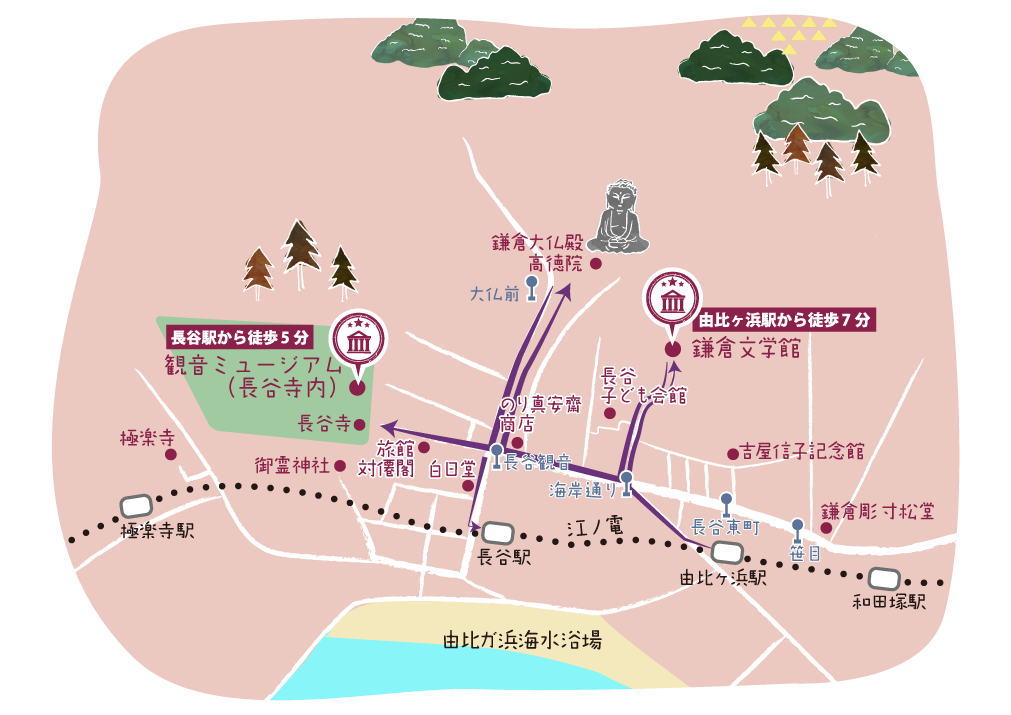
 Yuigahama Station Start
Yuigahama Station Start
Haiku by Takahama Kyoshi and Tanka by Yosano Akiko Why not stroll Yuigahama and Hase with the works of these poets?


Amanawa Shinmei Shrine
In these mountain recesses of Kamakura the sea could sometimes be heard at night. Shingo wondered if he might have heard the sound of the sea. But no--it was the mountain.
This shrine, said to have been founded in 710, is the oldest shrine in Kamakura. The Azuma Kagami, the chronicle of the Kamakura Shogunate, records that Minamoto Yoritomo and his wife Masako worshipped there. Kawabata Yasunari lived near the shrine and made this area the setting for his novel The Sound of the Mountain.

 7minutes-walk
7minutes-walk
 Curator's recommends
Curator's recommends

Hello. Oh, you can see the sea from the gallery!
The museum’s building was originally the summer home of the family of Marquess Maeda, which was built in 1936. On a clear day, you can see all the way to Oshima, an island off the Izu Peninsula from the windows that face seaward. The lighting fixtures and stained glass in each room of the museum are also not to be missed.


I’d say the “Kamakura Literati” corner in our Standing Exhibition Room 1. The Kamakura Literati organized some activities that were quite unique for writers associated with Kamakura. Kume Masao, Osaragi Jiro, and Kawabata Yasunari opened the Kamakura Bunko lending bookshop during World War II. They also organized carnivals and all sorts of other events in Kamakura. The panels present photographs from back then.


Komachi: Those are pretty unusual activities for serious writers. But, by the way, what Kamakura-related books would you recommend?


Shirasu: What else do you recommend?


 12minutes-walk
12minutes-walk
The erection of the Great Buddha at this temple is described in the Tokan Kiko, a travel journal from the Kamakura period. The temple precincts include a stele with this poem by Yosano Akiko and also one with a poem by the haiku poet Hoshino Tatsuko: “On wintry days, the Great Buddha shifts to the mountain.”


Tours of the interior of the Great Buddha (20 yen). While Natsume Soseki’s daughters were staying in Kamakura, they reported to their father that they had entered the interior of the Great Buddha. Soseki replied, “I’ve not gone in there yet. You’ve done a good thing” (August 10, 1912).

 7minutes-walk
7minutes-walk
This temple, commonly known as the Hasedera Kannon, has stele commemorating Takamatsu Kyoshi, with one of his haiku, and the critic Takayama Chogyu as well as a bust of the writer Kume Masao. The temple precincts are alive with the flowers of the seasons, with the hydrangeas of early summer and the autumn foliage particularly beautiful. The terrace next to the main hall offers an excellent view of Yuigahama.


Koizumi Yakumo (Lafcadio Hearn) described Hasedera as it was in the Meiji period in Glimpses of Unfamiliar Japan (1894). The main temple hall had no electric lights, of course. He found Kannon, gradually revealing herself out in the light of the lantern, quite moving. Hers is the face of “eternal youth and infinite tenderness,” he wrote.

 5minutes-walk
5minutes-walk
Search by themes
Search by areas
- Kita-Kamakura Station area
- Kamakura Station area
- Yuigahama Station area
- Hase Station area
- Gokurakuji Station area











